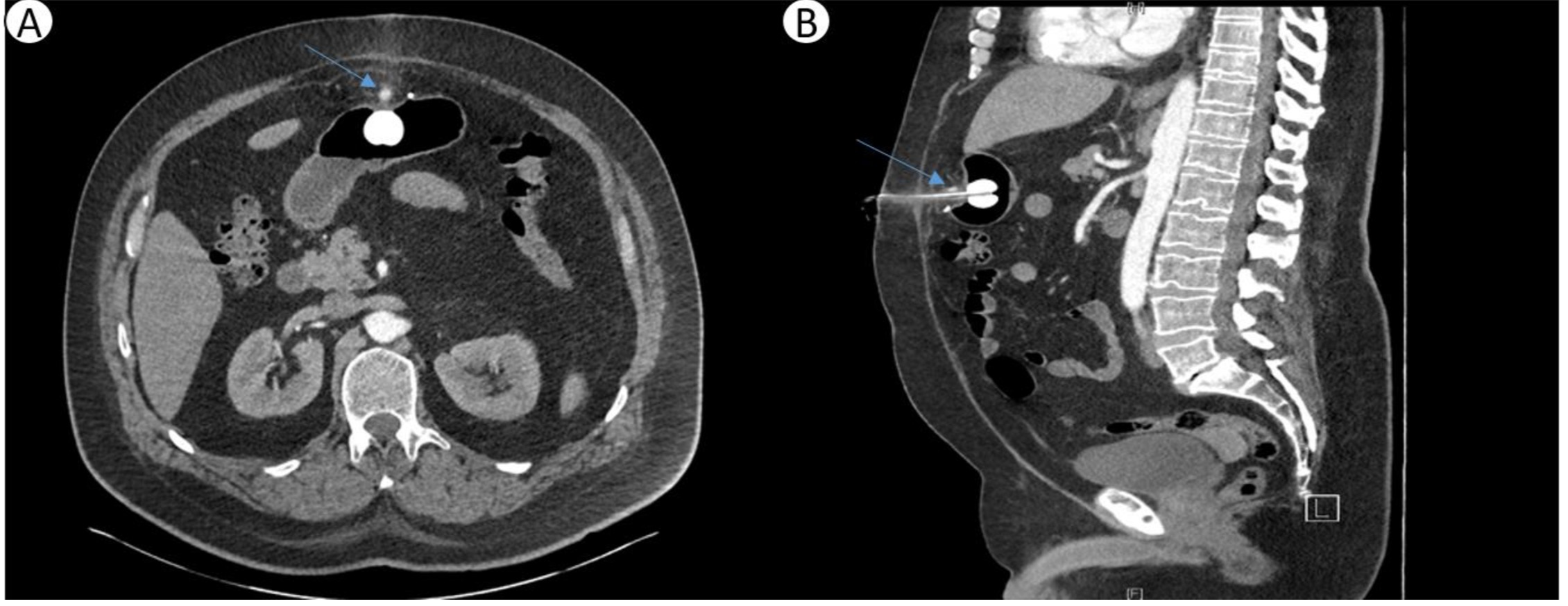Back
Poster Session C - Monday Afternoon
Category: GI Bleeding
C0336 - Bleeding From Peg Tube Insertion Site due to a Gastroepiploic Artery Pseudoaneurysm
Monday, October 24, 2022
3:00 PM – 5:00 PM ET
Location: Crown Ballroom
- SK
Sohaib Khan, MD
Parkview Medical Center
Pueblo, Colorado
Presenting Author(s)
Sohaib Khan, MD, Michael Harris, DO, Lirio Polintan, MD, Kumari Piryanka, MD
Parkview Medical Center, Pueblo, CO
Introduction: Percutaneous endoscopic gastrostomy (PEG) is generally regarded as a safe procedure with rare complications. Gastroepiploic artery aneurysms (GEAAs) are extremely rare with only 22 cases reported in the literature and constituting 3-4% of all splanchnic artery aneurysms. GEAAs carry a mortality rate of 70% due to a 90% rate of rupture and can lead to complications like hemorrhagic shock. Therefore, early detection and management is necessary for survival.
Case Description/Methods: A 55-year-old male with PEG tube placed for ALS-associated dysphagia presented with bleeding around the PEG tube site 10 days after placement. He was admitted twice for the complaint. On his first admission, EGD was normal and it was suspected that he had bleeding subcutaneously around the PEG site that self-resolved. He was discharged but promptly returned the next day with profuse bleeding around PEG tube. Emergent repeat EGD was again negative. This time, the diagnosis was confirmed with CTA of the abdomen that demonstrated a branch of the gastroepiploic artery that had an 8mm pseudoaneurysm. Interventional radiology successfully performed US-guided thrombin injection with successful thrombosis of the pseudoaneurysm. The patient’s PEG site bleeding stopped, and patient successfully discharged.
Discussion: Gastric bleeding following PEG tube placement is rare and usually occurs secondary to injury of the small gastric vessels. Due to the rotated configuration of stomach, caution should be exercised when penetrating during the PEG insertion. The gastroepiploic artery (GEA) runs along the greater curvature and may be injured during PEG tube placement although this is rare. The bleeding in our patient was due to a pseudoaneurysm of the GEA as evident from CT scan. GEA peudoaneurysms are a very rare complication that occur due to iatrogenic injury to the artery. GEA pseudoaneurysms can present as abdominal pain, bleeding, and even shock due to intraperitoneal hemorrhage. Due to the risk of fatal bleeding by GEA pseudoaneurysms, early detection and management is needed. Our patient was treated with percutaneous thrombin injection leading to resolution of bleeding. Other treatment options include trans arterial embolization and more invasive including surgical repair. Systemic embolization is the main complication of thrombin injection and can be prevented by placing the needle tip away from the neck of the pseudoaneurysm.

Disclosures:
Sohaib Khan, MD, Michael Harris, DO, Lirio Polintan, MD, Kumari Piryanka, MD. C0336 - Bleeding From Peg Tube Insertion Site due to a Gastroepiploic Artery Pseudoaneurysm, ACG 2022 Annual Scientific Meeting Abstracts. Charlotte, NC: American College of Gastroenterology.
Parkview Medical Center, Pueblo, CO
Introduction: Percutaneous endoscopic gastrostomy (PEG) is generally regarded as a safe procedure with rare complications. Gastroepiploic artery aneurysms (GEAAs) are extremely rare with only 22 cases reported in the literature and constituting 3-4% of all splanchnic artery aneurysms. GEAAs carry a mortality rate of 70% due to a 90% rate of rupture and can lead to complications like hemorrhagic shock. Therefore, early detection and management is necessary for survival.
Case Description/Methods: A 55-year-old male with PEG tube placed for ALS-associated dysphagia presented with bleeding around the PEG tube site 10 days after placement. He was admitted twice for the complaint. On his first admission, EGD was normal and it was suspected that he had bleeding subcutaneously around the PEG site that self-resolved. He was discharged but promptly returned the next day with profuse bleeding around PEG tube. Emergent repeat EGD was again negative. This time, the diagnosis was confirmed with CTA of the abdomen that demonstrated a branch of the gastroepiploic artery that had an 8mm pseudoaneurysm. Interventional radiology successfully performed US-guided thrombin injection with successful thrombosis of the pseudoaneurysm. The patient’s PEG site bleeding stopped, and patient successfully discharged.
Discussion: Gastric bleeding following PEG tube placement is rare and usually occurs secondary to injury of the small gastric vessels. Due to the rotated configuration of stomach, caution should be exercised when penetrating during the PEG insertion. The gastroepiploic artery (GEA) runs along the greater curvature and may be injured during PEG tube placement although this is rare. The bleeding in our patient was due to a pseudoaneurysm of the GEA as evident from CT scan. GEA peudoaneurysms are a very rare complication that occur due to iatrogenic injury to the artery. GEA pseudoaneurysms can present as abdominal pain, bleeding, and even shock due to intraperitoneal hemorrhage. Due to the risk of fatal bleeding by GEA pseudoaneurysms, early detection and management is needed. Our patient was treated with percutaneous thrombin injection leading to resolution of bleeding. Other treatment options include trans arterial embolization and more invasive including surgical repair. Systemic embolization is the main complication of thrombin injection and can be prevented by placing the needle tip away from the neck of the pseudoaneurysm.

Figure: Figure A (axial) and B (sagittal): Arrows represent a small 8 mm pseudoaneurysm off of the gastroepiploic artery at the level of the gastrostomy tube insertion site.
Disclosures:
Sohaib Khan indicated no relevant financial relationships.
Michael Harris indicated no relevant financial relationships.
Lirio Polintan indicated no relevant financial relationships.
Kumari Piryanka indicated no relevant financial relationships.
Sohaib Khan, MD, Michael Harris, DO, Lirio Polintan, MD, Kumari Piryanka, MD. C0336 - Bleeding From Peg Tube Insertion Site due to a Gastroepiploic Artery Pseudoaneurysm, ACG 2022 Annual Scientific Meeting Abstracts. Charlotte, NC: American College of Gastroenterology.
